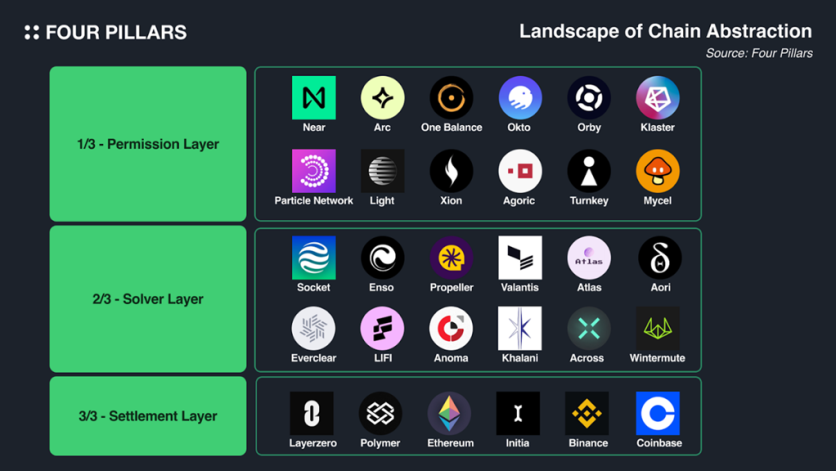The current state of crypto applications is a tangled mess. Users juggle multiple wallets, navigate complex interfaces to move assets between chains, and spend a significant amount of time wrestling with gas fees. Enter chain abstraction: a movement aiming to simplify this multi-chain chaos.
This article sheds light on the vision of chain abstraction and how it will usher in a truly seamless crypto user experience—one where users can interact with applications on any chain without ever needing a blockchain engineering degree.
We'll also dive into how LI.FI acts as the engine powering the next generation of applications with its multifaceted tech stack.
Chain Abstraction: Simplifying Crypto UX
Imagine interacting with crypto like using any other app—no more hurdles or steep learning curves—chain abstraction is the ambitious movement striving for exactly that. It's not a single product or feature but, rather, a philosophical shift towards application development aimed at simplifying the user experience as the number of chains in the ecosystem rapidly increases.
The ideal scenario? Seamless interaction with any application on any chain, where the underlying complexities are invisible. Gone are the days of juggling wallets, battling gas fees, and deciphering blockchain tools. In a chain-abstracted world, the focus is solely on the application and its benefits to users.
The billion-dollar question is how do we bridge the gap to this ideal UX? It all comes down to abstraction—hiding unnecessary technical details, leaving users to focus on the use cases of applications.
Chain abstraction isn't a one-size-fits-all solution. It's a philosophy that embraces a variety of approaches. LI.FI crypto, for instance, champions the power of aggregation and abstraction and acts as a marketplace that gathers the best liquidity sources from bridges, DEXs, solvers, and other aggregators. Users simply place their orders and LI.FI automatically finds the most efficient route at the best rate, shielding them from the underlying complexities.
Let's explore how LI.FI fits within existing frameworks of understanding this dynamic:
1. Orchestration Solutions
Orchestration services, as the framework by The Rollup Co aptly defines them, are tools or platforms that streamline and automate user actions across multiple chains. They act as intermediaries, coordinating everything from RPCs at the blockchain level to price estimates at the infrastructure level—all with the sole goal of providing a user-friendly interface that allows users to execute multi-chain actions with a single click.
For users, orchestration services translate into a seamless and unified experience. No more navigating complex bridges or DEXs; just interact with the dApps you love, and developers benefit tremendously as well. They can ditch the tedious task of integrating with individual blockchain infrastructure. Instead, orchestration tools like LI.FI acts as a one-stop shop, allowing developers to focus on what truly matters: building applications with a user-centric design.
The beauty of DeFi is that everything is composable. This means that LI.FI's tech stack can be combined with other available technologies to build even more sophisticated chain abstraction tool kits to power applications. Klaster, Aarc, Okto, and OneBalance are examples of such chain abstraction projects using LI.FI.
2. Solver Layer
The "solver layer" in chain abstraction frameworks, as defined by CAKE and Four Pillars, handles a critical task: ensuring the most efficient execution of user orders. Think of it as a team of experts working behind the scenes to find the best deals for your crypto transactions.
LI.FI is an aggregator, bringing together various solver options under one roof. Imagine a marketplace filled with different vendors—bridges, DEXs that run solver auctions, and even individual solvers. LI.FI gathers them all, along with their unique features, and presents them to applications in a single, streamlined package.
This empowers developers who build those applications with incredible flexibility. They can now choose the perfect solver for each user order, taking factors like fees, transaction speed, and specific user requirements into account. Ultimately, the solver layer ensures a seamless and cost-effective experience for users.
But LI.FI's value extends beyond developer convenience. Consider the perspective of enterprise applications like Robinhood, Phantom, and MetaMask—some of LI.FI's esteemed clients. These companies prioritize a few key things:
- delivering the best prices and execution for their users,
- maintaining redundancy to avoid reliance on single providers,
- future-proofing in-app features, and
- minimizing maintenance and technical overhead.
LI.FI offers a one-stop solution for all these concerns, acting as a guide leading enterprises through the chain abstraction narrative and transition. LI.FI helps them understand how solutions are already paving the way for a seamless multi-chain user experience, alleviating the burden of in-house development and ensuring they remain at the forefront of innovation.
3. Orderflow Sources
Platforms like Uniswap and LI.FI are categorized as "orderflow sources" by frameworks like Rollupco's. Orderflow sources are tools that capture users' intents. These intents can range from basic swaps and cross-chain transfers to staking on new chains.
Here's where network effects of distribution come into the picture: any application that is integrated widely across the DeFi ecosystem has the power of a strong distribution network, effectively collecting user intents from a diverse range of applications.
For example, LI.FI has integrations with over 250 applications, including top wallets, on-ramps, DeFi protocols, and front-ends like Jumper.Exchange that leverage LI.FI's services for executing user intents. The more apps that integrate LI.FI, the stronger its distribution network becomes, making LI.FI a dominant orderflow source able to aggregate user intents and generate valuable insights for the whole ecosystem.

Closing Thoughts
The current state of crypto holds immense potential, but the user experience can be daunting. Chain abstraction, spearheaded by projects like LI.FI offers a glimpse into a future where interacting with crypto applications is as effortless as using any other everyday app.
It is exciting to see how the chain-abstracted future unfolds and to play a major role in helping applications and enterprises navigate the complexities of building in crypto.
ⓒ 2025 TECHTIMES.com All rights reserved. Do not reproduce without permission.







